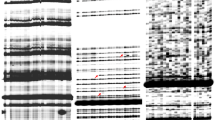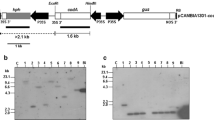Summary
To develop a transposon tagging system in an important cereal plant, rice (Oryza sativa L.), the maize transposable element Ac (Activator) was introduced into rice protoplasts by electroporation. We employed a phenotypic assay for excision of Ac from the selectable hph gene encoding resistance to hygromycin B. Southern blot analysis of hygromycin B-resistant calli showed that the Ac element can transpose from the introduced hph gene into the rice chromosomes. Sequence analysis of several Ac excision sites in the hph gene revealed sequence alterations characteristic of the excision sites of this plant transposable element. The Ac element appears to be active during development of transgenic rice plants from calli. Moreover, hybridization patterns of different leaves from the same plant indicated that some Ac elements are stable whereas others are able to transpose further during development of leaves. The results indicate that the introduced Ac element can transpose efficiently in transgenic rice plants.
Similar content being viewed by others
References
Baker B, Schell J, Lörz H, Fedoroff N (1986) Transposition of the maize controlling element “Activator” in tobacco. Proc Natl Acad Sci USA 83:4844–4848
Baker B, Coupland G, Fedoroff N, Starlinger P, Schell J (1987) Phenotypic assay for excision of the maize controlling element Ac in tobacco. EMBO J 6:1541–1554
Behrens U, Fedoroff N, Laird A, Miiller-Neumann M, Starlinger P, Yoder JI (1984) Cloning of the Zea mays controlling element Ac from the wx-m7 allele. Mol Gen Genet 194:346–347
Bennett MD, Smith JB, Heslop-Harrison JS (1982) Nuclear DNA amounts in angiosperms. Proc R Soc Lend B 216:179–199
Bilang R, Iida S, Peterhans A, Potrykus I, Paszkowski J (1990) The 3′-terminal region of the hygromycin B resistance gene is important for its activity in Escherichia coli and in Nicotiana tabacum. Gene, in press
Coen ES, Robbins TP, Almeida J, Hudson A, Carpenter R (1989) Consequences and mechanisms of transposition in Antirrhinum majus. In: Berg DE, Howe MM (eds) Mobile DNA. Am Soc Microbiol, Washington DC, pp 413–436
Coupland G, Baker B, Schell J, Starlinger P (1988) Characterization of the maize transposable element Ac by internal deletions. EMBO J 7:3656–3659
Cuzzoni E, Ferretti L, Giordani C, Castiglione S, Sala F (1990) A repeated chromosomal DNA sequence is amplified as a circular extrachromosomal molecule in rice (Oryza sativa L.). Mol Gen Genet 222:58–64
Dooner HK, English J, Ralston E (1988) The frequency of transposition of the maize element Activator is not affected by an adjacent deletion. Mol Gen Genet 211:485–491
Döring H-P, Starlinger P (1986) Molecular genetics of transposable elements in plants. Annu Rev Genet 20:175–200
Fedoroff NV (1989) Maize transposable elements. In: Berg DE, Howe MM (eds) Mobile DNA. Am Soc Microbiol, Washington DC, pp 375–411
Finnegan EJ, Taylor BH, Craig S, Dennis E (1989) Transposable elements can be used to study cell lineages in transgenic plants. Plant Cell 1:757–764
Frey M, Tavantzis SM, Saedler H (1989) The maize En-I/Spm element transposes in potato. Mol Gen Genet 217:172–177
Gritz L, Davies J (1983) Plasmid-encoded hygromycin B resistance: the sequence of hygromycin B phospotransferase gene and its expression Escherichia coli and Saccharomyces cerevisiae. Gene 25:179–188
Jones JDG, Carland FM, Maliga P, Dooner HK (1989) Visual detection of the maize element Activator (Ac) in tobacco seedlings. Science 244:204–207
Kinoshita T (1984) Gene analysis and linkage map. In: Tsunoda S, Takahashi N (eds) Biology of rice. Elsvier, Amsterdam, pp 187–274
Klösgen RB, Gierl A, Schwartz-Sommer Z, Saedler H (1986) Molecular analysis of the waxy locus of Zea mays. Mol Gen Genet 203:237–244
Knapp S, Coupland G, Uhring U, Starlinger P, Salamini F (1988) Transposition of the maize transposable element Ac in Solanum tuberosum. Mol Gen Genet 213:285–290
Kyozuka J, Hayashi Y, Shimamoto K (1987) High frequency plant regeneration from rice protoplasts by novel nurse culture methods. Mol Gen Genet 206:408–413
Laufs J, Wirtz U, Kammann M, Matzeit V, Schaefer S, Schell J, Czernilofsky AP, Baker B, Gronenborn B (1990) Wheat dwarf virus Ac/Ds vectors: Expression and excision of transposable elements introduced into various cereals by a viral replicon Proc Natl Acad Sci USA. 87:7752–7756
Martin C, Prescott A, Lister C, MacKay S (1989) Activity of the transposon Tam3 in Antirrhinum and tobacco: Possible role of DNA methylation. EMBO J 8:997–1004
Masson P, Fedoroff NV (1989) Mobility of the maize Suppressormutator element in transgenic tobacco cells. Proc Natl Acad Sci USA 86:2219–2223
Masson P, Rutherford G, Banks JA, Fedoroff N (1989) Essential large transcripts of the maize Spm transposable element are generated by alternative splicing. Cell 58:755–765
McClintock B (1951) Chromosome organization and genetic expression. Cold Spring Harbor Symp Quant Biol 16:13–47
Müller-Neumann M, Yoder JI, Starlinger P (1984) The DNA sequence of the transposable elements Ac of Zea mays L. Mol Gene Genet 198:19–24
Nevers P, Shepherd NS, Saedler H (1986) Plant transposable elements. Adv Bet Res 12:103–203
Pereira A, Saedler H (1989) Transposition behavior of the maize En/Spm element in transgenic tobacco. EMBO J 8:1315–1321
Pietrzak M, Shillito RD, Hohn T, Potrykus I (1986) Expression in plants of two bacterial antibiotic resistance genes after protoplast transformation with a new plant expression vector. Nucleic Acids Res 14:5857–5868
Pohlman R, Fedoroff NV, Messing J (1984) The nucleotide sequence of the maize controlling element Activator. Cell 37:635–643
Saiki RK, Gelfand DH, Stoffel S, Scharf SJ, Higuchi R, Horn GT, Mullis KB, Erlich HA (1988) Primer-directed enzymatic amplification of DNA with a thermostable DNA polymerase. Science 239:487–491
Sanger F, Nicklen S, Coulson AR (1977) DNA sequencing with chain-terminating inhibitors. Proc Natl Acad Sci USA 74:5463–5467
Shepherd NS (1987) Transposable elements and gene-tagging. In: Shaw C (ed) Plant molecular biology: A practical approach. IRL Press, London, pp 187–220
Shimamoto K, Terada R, Izawa T, Fujimoto H (1989) Fertile transgenic rice plants regenerated from transformed protoplasts. Nature 338:274–276
Southern EM (1975) Detection of specific sequences among DNA fragments separated by gel electrophoresis. J Mol Biol 98:503–517
Spena A, Aalen RB, Schulze SC (1989) Cell-autonomous behavior of the roIC gene of Agrobacterium rhizogenes during leaf development: A visual assay for transposon excision in transgenic plants. Plant Cell 1:1157–1164
Terada R, Shimamoto K (1990) Expression of CaMV35S-GUS gene in transgenic rice plants. Mol Gen Genet 220:389–392
Van Sluys MA, Tempé J, Fedoroff N (1987) Studies on the introduction and mobility of the maize Activator element in Arabidopsis thaliana and Daucus carota. EMBO J 6:3881–3889
Vieira J, Messing J (1982) The pUC plasmids, and M13mp7-derived system for insertion mutagenesis and sequencing with synthetic universal primers. Gene 19:259–268
Wienand U, Saedler H (1988) Plant transposable elements: unique structures for gene tagging and gene cloning. In: Hohn T, Schell J (eds) Plant DNA infectious agents. Springer, Wien, pp 205–228
Yanisch-Perron C, Vieira J, Messing J (1985) Improved M13 phage cloning vectors and host strains: nucleotide sequences of the M13mp18 and pUC19 vectors. Gene 33:103–119
Yoder JI, Palys J, Alpert K, Lassner M (1988) Ac transposition in transgenic tomato plants. Mol Gen Genet 213:291–296
Zhou JH, Atherly AG (1990) In situ detection of transposition of the maize controlling element (Ac) in transgenic soybean tissue. Plant Cell Rep 8:542–545
Author information
Authors and Affiliations
Additional information
Communicated by H. Saedler
Rights and permissions
About this article
Cite this article
Izawa, T., Miyazaki, C., Yamamoto, M. et al. Introduction and transposition of the maize transposable element Ac in rice (Oryza sativa L.). Molec. Gen. Genet. 227, 391–396 (1991). https://doi.org/10.1007/BF00273928
Received:
Issue Date:
DOI: https://doi.org/10.1007/BF00273928




